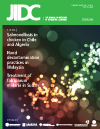The effect of Point Mutations in Dihydrofolate reductase genes and Multidrug resistance gene 1-86 on treatment of falciparum malaria in Sudan
DOI:
https://doi.org/10.3855/jidc.630Keywords:
Antimalarial drugs, P. falciparum, dhfr, mdr-1, dot-blot hybridisation technique, PCR/RFLPAbstract
Background: One of the major problems to the treatment of malaria is the emergence and spread of parasite resistant to antimalarial drugs. Due to increased chloroquine (CQ) resistance, the antifolate combinations are becoming important in the chemotherapy of falciparum malaria. However, resistance to antifolate exists and they are still effective in the above combinations. This study aimed at determining the prevalence of antimalarial drug resistance markers in P. falciparum isolates, involving the detection of mutations at the mdr 1- 86 which associates with amodiaquine resistance, and dhfr mutations associated with SP resistances. Methods: The dot-blot/ probe hybridization, which is more sensitive and specific; it detects parasitaemia of less than 100 parasites/µl of blood, and can identify a minority parasite genotype down to 1% in a mixture, was adopted to determine multi-drug resistance (mdr1-86) to show the correlation of Amodiaquine (AQ) resistance and PCR/ RFLP adopted to determine dihydrofolate reductase (dhfr) baseline resistance to Sulphadoxine- Pyrimethamine (SP) resistance in Nubian region of southern Sudan. A randomized open label trial of Artesunate (AS) + SP and AS+ SP was carried out in children less than 5 years. Molecular analysis of filter paper preserved blood samples collected was carried out to provide a baseline estimate of allele prevalences. Results: Baseline of the allele prevalence of the mdr1 86 locus in the AS+ AQ was successful for 80 isolates: 71(8.11%) carried parasites harbouring the mdr1-86 Tyr resistance allele, while 7 (89.19%) carried mdr1-86 Asn sensitivity allele and 2 (2.7%) were of mixed infection, having both resistance and wild type allele. Overall, the prevalence of the dhfr point mutation, codon 51, 59 and 108: 82.5% (132/160) carried mutations at dhfr (N51I, C59R or S108N), but triple mutants were rare (3.1%) in the AS + SP arm. Conclusion: The research provides the evidence that mutations present in dhfr and mdr1 86 has a significant effect on the type of treatment following SP and AQ chemotherapy. SP resistance may spread rapidly, and AS + AQ is likely to be a better option, provided AQ use is restricted to the combination. The significance of the study shows that definitely combination of drugs improves SP therapy at the study site. Keywords: Antimalarial drugs, P. falciparum, dhfr, mdr-1, dot-blot hybridisation technique, PCR/RFLPDownloads
Published
2009-11-21
How to Cite
1.
Yusuf RU, Omar SA, Ngure RM (2009) The effect of Point Mutations in Dihydrofolate reductase genes and Multidrug resistance gene 1-86 on treatment of falciparum malaria in Sudan. J Infect Dev Ctries 4:061–069. doi: 10.3855/jidc.630
Issue
Section
Emerging Problems in Infectious Diseases
License
Authors who publish with this journal agree to the following terms:
- Authors retain copyright and grant the journal right of first publication with the work simultaneously licensed under a Creative Commons Attribution License that allows others to share the work with an acknowledgement of the work's authorship and initial publication in this journal.
- Authors are able to enter into separate, additional contractual arrangements for the non-exclusive distribution of the journal's published version of the work (e.g., post it to an institutional repository or publish it in a book), with an acknowledgement of its initial publication in this journal.
- Authors are permitted and encouraged to post their work online (e.g., in institutional repositories or on their website) prior to and during the submission process, as it can lead to productive exchanges, as well as earlier and greater citation of published work (See The Effect of Open Access).








